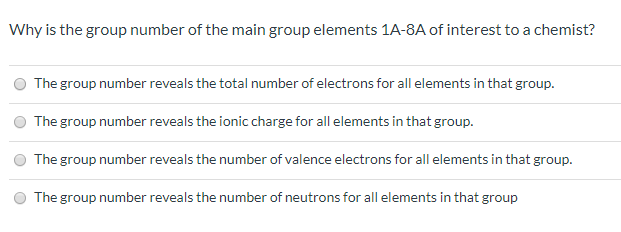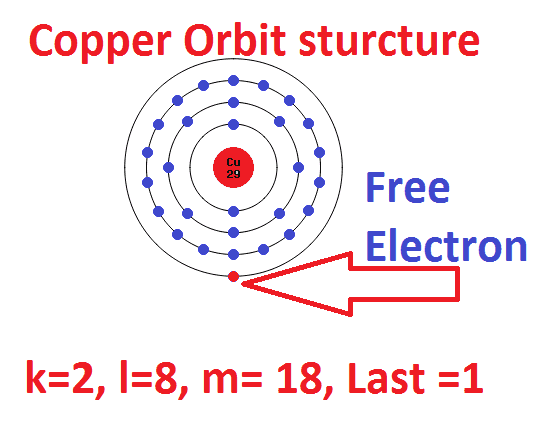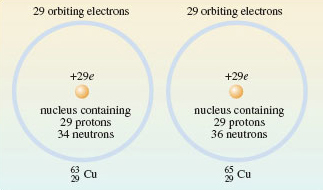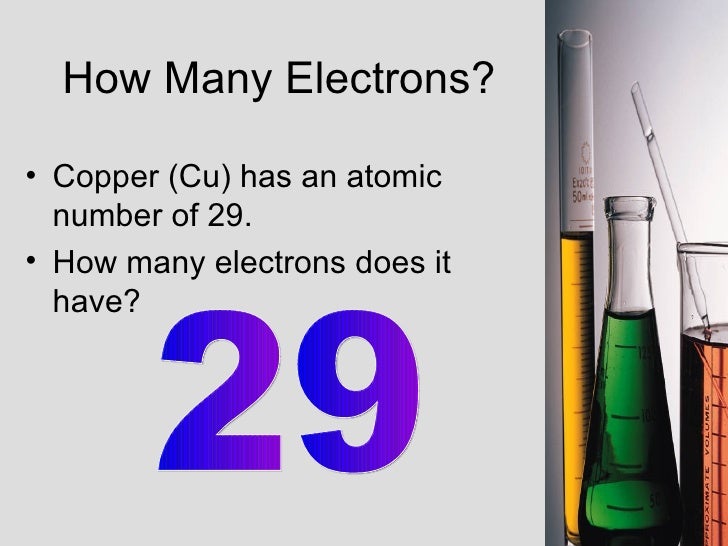Number Of Electrons In Copper
This page looks at how to do routine electrolysis calculations.
The Faraday Constant
The Faraday constant is the single most important bit of information in electrolysis calculations. Make sure you really understand the next bit.
Name: Copper Symbol: Cu Atomic Number: 29 Atomic Mass: 63.546 amu Melting Point: 1083.0 °C (1356.15 K, 1981.4 °F) Boiling Point: 2567.0 °C (2840.15 K, 4652.6 °F) Number of Protons/Electrons: 29 Number of Neutrons: 35 Classification: Transition Metal Crystal Structure: Cubic Density @ 293 K: 8.96 g/cm 3 Color: red/orange Atomic Structure. As one Copper atoms contributes one free electron. Thus number of free electrons N e = N C u = 8. 4 × 1 0 2 2 electrons per c m 3 Answer verified by Toppr.
Coulombs
The coulomb is a measure of the quantity of electricity. If a current of 1 amp flows for 1 second, then 1 coulomb of electricity has passed.
That means that you can work out how much electricity has passed in a given time by multiplying the current in amps by the time in seconds.
If you are given a time in minutes or hours or days, then you must convert that into seconds before you do anything else.
For example, if a current of 2 amps flows for an hour, then:
The Faraday
Electricity is a flow of electrons. For calculation purposes, we need to know how to relate the number of moles of electrons which flow to the measured quantity of electricity.
The charge that each electron carries is 1.60 x 10-19 coulombs. If you ever needed to use it in an exam, you would be given the value.
1 mole of electrons contains the Avogadro constant, L, electrons – that is 6.02 x 1023 electrons. You would also be given that in an exam if you needed to use it.
That means the charge 1 mole of electrons carries is
This value is known as the Faraday constant.
You may come across the formula F = Le, where F is the Faraday constant, L is the Avogadro constant and e is the charge on an electron (in terms of the number of coulombs it carries). We have just used that without actually stating it – it is basically obvious!
The numbers we are using here are rounded off, so our calculated value is a little off. The calculation just shows you how to work it out if you have to, but doesn't give the normally-used value. For exam purposes, the value of the Faraday constant is usually taken as 9.65 x 104 C mol-1 (coulombs per mole). This is another number you are unlikely to have to remember.
That is 96500 coulombs per mole.
So 96500 coulombs is called 1 faraday. Notice the small 'f' when it is used as a unit.
Whenever you have an equation in which you have 1 mole of electrons, that is represented in an electrical circuit by 1 faraday of electricity – in other words, by 96500 coulombs.
Note: I have said three times that a piece of information is likely to be given to you in an exam, but you need to be sure. Check your syllabus to find out what is contained in the Data Booklet you are likely to be given. You will normally find this towards the end of the syllabus.
Using the Faraday Constant in Calculations
Electrolysis calculations are no more difficult than any other calculation from an equation. In fact, you may well have done them as a part of whatever course you did before you started doing A level.
We will just look at four examples.
Example 1
Calculate the mass of silver deposited at the cathode during the electrolysis of silver nitrate solution if you use a current of 0.10 amps for 10 minutes.
The first thing to do is to work out how many coulombs of electricity flowed during the electrolysis.

Now look at the equation for the reaction at the cathode:
Just as with any other calculation from an equation, write down the essential bits in words:
1 mole of electrons gives 1 mole of silver atoms
Now put the numbers in: 1 mol of electrons is 1 faraday.
96500 coulombs give 108 g of silver
So, if 96500 coulombs give 108 g of silver, all you have to do is to work out what mass of silver would be produced by 60 coulombs.

Neutrons In Copper
Note: If your maths is really bad, so that you aren't happy about simple proportion sums, then think of it like this:
If 96500 coulombs gives 108 grammes, then 1 coulomb would give (108 divided by 96500) grammes. 60 coulombs would produce 60 times this amount.
It doesn't matter in the least how you work this out – all that matters for your chemistry is that you get the answer right!
Example 2
This example shows you how to do the calculation if the product you are interested in is a gas.
Calculate the volume of hydrogen produced (measured at room temperature and pressure – rtp) during the electrolysis of dilute sulfuric acid if you use a current of 1.0 amp for 15 minutes.
Start by working out how many coulombs of electricity flowed during the electrolysis.
Now look at the equation for the reaction at the cathode:

Write down the essential bits in words:
2 mol of electrons give 1 mol of hydrogen, H2
Now put the numbers in. Two moles of electrons is 2 faradays.
2 × 96500 coulombs give 24 dm3 H2 at rtp
So, if 2 x 96500 coulombs give 24 dm3 H2, work out what volume of hydrogen would be produced by 900 coulombs.
Don't quote your answer beyond 2 decimal places. The current and the molar volume are only quoted to that degree of accuracy.
Note: If you can't follow the last bit of the calculation:
If 2 x 96500 coulombs give 24 dm3 H2, then 1 coulomb would give (24 divided by 2 x 96500) dm3. 900 coulombs would produce 900 times this amount.
In other words, you are working out 24/(2 x 96500) and then multiplying by 900. It is a different order from the way it is shown in the simple proportion sum shown above, but the answer is still exactly the same.
In addition, if you feel happier working out the value of 2 x 96500 before you do anything else, that's what you should do. As long as you get the answer right, nobody is interested in the exact way you handle the sums.
Example 3
This example shows you what to do if the question is reversed.
How long would it take to deposit 0.635 g of copper at the cathode during the electrolysis of copper(II) sulfate solution if you use a current of 0.200 amps.
This time you can't start by working out the number of coulombs, because you don't know the time. As with any other calculation, just start from what you know most about. In this case, that's the copper, so start with the electrode equation.
Write down the important bits of this in words:

2 moles of electrons produce 1 mole of copper atoms
Now put the numbers in. The charge of 1 mole of electrons is 1 faraday.

2 × 96500 coulombs give 63.5 g of copper
You need to work out how many coulombs give 0.635 g of copper.
Note: And again, if you still don't like simple proportion sums:
If 2 x 96500 coulombs give 63.5g of copper, then you would get 1g of copper if you divided the 2 x 96500 coulombs by 63.5. 0.635 g would be produced by multiplying this by 0.635.
Now what?
You know how many coulombs you need, and you know what the current was in amps. You have got all the information you need to work out the time.
Don't waste time trying to convert that into minutes or hours (unless the exam question specifically asks you to).
Example 4
Another gas example:
Calculate the volume of oxygen produced, measured at room temperature and pressure (rtp), during the electrolysis of sodium sulfate solution if you use a current of 0.50 amps for 30 minutes.
Start by working out how many coulombs of electricity flowed during the electrolysis.
Now we need to look at the equation for the reaction at the anode. Unfortunately, there are two ways of looking at this, and you may come across either of them.
The first one releases oxygen from water molecules:
The alternative way releases oxygen from hydroxide ions from the ionisation of the water:
Write down the essential bits in words. Both ways of looking at it say the same thing:
Releasing 1 mol of oxygen, O2, involves 4 mol of electrons
Now put the numbers in. Four moles of electrons has a charge of 4 faradays.
4 × 96500 coulombs give 24 dm3 O2 at rtp
So, if 4 x 96500 coulombs give 24 dm3 H2, work out what volume of oxygen would be produced by 900 coulombs.
Don't quote your answer beyond 2 decimal places. The current and the molar volume are only quoted to that degree of accuracy.
Questions to test your understanding
Questions on basic electrolysis calculationsAnswersWhere would you like to go now?
To the Electrolysis menuTo the Inorganic Chemistry menuTo Main MenuThe Fermi energy is the maximum energy occupied by an electron at 0K. By the Pauli exclusion principle, we know that the electrons will fill all available energy levels, and the top of that 'Fermi sea' of electrons is called the Fermi energy or Fermi level. One of the remarkable things about the Fermi energy is how large it is compared to the energies which electrons could gain by ordinary physical interactions with their environment.
The amount of energy available as a result of the temperature of the material is on the order of the average thermal energy, for which kT= .026 eV at 300K is a representative number. This is very small compared to the Fermi energy of 7 eV for copper. This tells us that that thermal energy can interact with only a tiny fraction of the electrons (roughly .026/7 or about 0.4% of the energy range), since the overwhelming majority of the electrons are separated from the top of the Fermi sea by much more than thermal energy. This correlates well with the observation that electrons do not contribute significantly to the specific heat of solids at ordinary temperatures. Only at very low temperatures does the electron specific heat become significant.
Since there is a vast sea of electrons, it may be easier to visualize the unavailability of final states with a simpler system - that of atomic electrons which must obey the Pauli exclusion principle. At left below in the example of a chlorine atom, energy could be received from photons which match the energy gap between n=1 and n=2 because there is an energy vacancy in the n=2 level. But for neon, even a photon which matches the energy E2-E1 precisely cannot be absorbed because all the available levels are filled.
Protons In Copper
The vast majority of the free electrons are likewise unavailable to the process of ordinary electrical conduction in wires for the same kind of reasons. When you apply a voltage to a copper wire, you establish an electric field in the wire which can do work on the electrons to give them energy. But the example of copper wire conduction shows that the mean free path of electrons in a copper wire at room temperature is in the neighborhood of 40 nm. So the energy given to an electron by the electric field by 100 volts applied to a 1 meter copper wire would be on the order of W=eEd = 100 volts x 40 nm = 0.000004 eV. Such an amount of energy cannot be absorbed by most of the electrons because there is no available energy level that close to them in energy.
